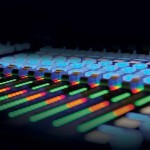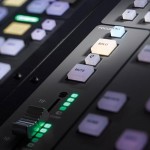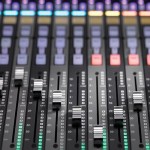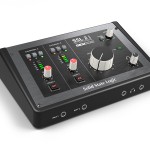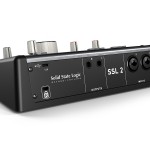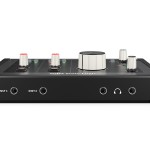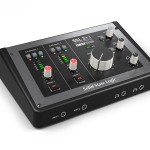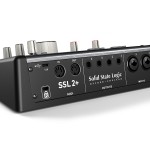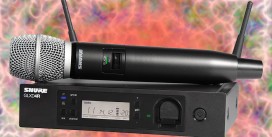Let’s be real: most audio interfaces are good enough these days. But good enough isn’t the bar anymore—especially not if you’re the kind of creator who takes pride in your setup, who notices the tactile feedback of a knob or the satisfying smoothness of a gain dial. That’s where the Solid State Logic 2+ comes in. It simply shows up with confidence, delivers top-tier sound, and makes you feel like you’re working with gear that actually respects your time and ears. And this isn’t about overhype. This is about experiencing something and going: “Yeah, that’s how it should feel” – so let’s break it all down!
Overview
The SSL 2 MKII (2-in/2-out) and SSL 2+ MKII (2-in/4-out) are compact, bus-powered USB-C interfaces aimed at home studios, streamers, and podcasters. They come in signature solid black chassis, large monitor knob and dual headphone outputs (labeled A/B) with gain knobs for each channel front-and-center. A dedicated “Mix” knob lets you blend the live inputs with DAW playback, and there’s a mono (stereo-sum) switch for the two inputs. All front-panel jacks (dual combo XLR/¼″ for mics/lines, plus two high‑impedance instrument inputs) use Neutrik connectors. The build is solidly put together, and it even uses Alps potentiometers for the knobs, which are pretty costly. The units feel very solid in hand, weighing about 1kg, but still convenient for travel. The top cover and controls are stable and well-built, with no wobble or flex on the circuit board.
- Controls: Front-panel controls include gain knobs (with peak LEDs), individual +48 V and HPF switches per channel, the Legacy 4K button, a monitor level knob, a Mix knob, a mono (stereo-sum) button, and two headphone level knobs. The 4K “analogue enhancement” button is a hallmark Solid State Logic feature – it adds a subtle high-frequency lift and harmonic coloration reminiscent of their consoles’ sound. This mode gives guitars and vocals a ‘forward, excited’ character—hard to define, but undeniably addictive.
- Aesthetics: This wouldn’t be a solid state logic product if not for aestetics! Those sexy looks, black metal case… mmm, professional firm-feel knobs and buttons that are so satisfying to work with, and even the LEDs’ style – this is where everything is just top notch and screams QUALITY all over the place, but it’s one thing to see it on the pic and another is to actually hold it, touch it and own it!
- Build Quality: Internally, the SSL 2/2+ MKII share a well-assembled steel/aluminum chassis. Cables and components fit tightly with Neutrik jacks on every XLR/TRS input and output. The connectors also have a satisfying tactile click when you plug in, making sure everything is well-secured. The knobs and switches are also sturdy; Alps knobs on the front panel give it a very precise feel. Unlike most chinese knock offs which nowadays are very common, I can see how this thing could even easily outlast the rest of your gear, so consider it a worthy investment.
Preamps and Audio Performance
Solid State Logic emphasizes audio quality in these interfaces. Both models use proprietary mic preamps with 64 dB of gain and extremely low noise. In lab terms, the mic inputs reach ~116.5 dB dynamic range, allowing to capture virtually every detail from any source. The converters are next-gen – 32-bit/192 kHz, so you get very high-fidelity audio with a full range sampling rate. In practice these ADCs, paired with extremely quiet preamps deliver unaltered frequency response and ultra-low noise floor. And even gain-greedy mics like SM7B can be driven at good levels without a Cloudlifter (or additional preamps).
When it comes to actual sound, SSL2 MK2 could be praised for their clarity and transparency. The end result being no bullshit/ no compromise studio quality, and when combined with a quality source it could be rightfully defined as stunning. You could also do a quick search and see that other reviews support our stance. The claimed specs like very wide dynamic range can be easily measured and verified, and these specs also mean a lot of clean headroom, and if any potential distortions are negligible compared to a typical source, even when using top tier recording microphones etc. The headphone outputs are also very beefy and can drive low impedance headphones without compromising the low end, so everything is crisp and clear even at high volumes.
SSL 4K Legacy Mode: The dedicated 4K switch is a signature SSL feature that adds analog “mojo.” It works via a small analog circuit that injects harmonics and boosts high frequencies. The idea of boosting the latter is not new as it makes sources more forward and helps instruments like guitar and vocals cut through. But it’s not a drastic effect – more like a gentle brightness enhancer that adds a pleasant, natural crispness. If you want ultra-neutral recording, you can leave it off; otherwise it’s an easy way to add console character at the preamp stage.
Drivers and Bundled Software:
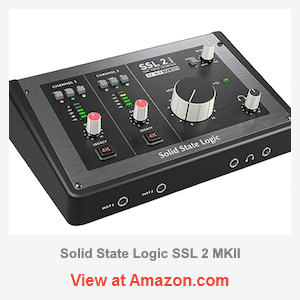 The interface is essentially plug-and-play – no complicated setup required. Its drivers (class-compliant on both Mac and PC) are solid and seldom have issues. When it comes to actual use it feels very straight forward, since most functions (gain, phantom, etc.) are hardware-based.
The interface is essentially plug-and-play – no complicated setup required. Its drivers (class-compliant on both Mac and PC) are solid and seldom have issues. When it comes to actual use it feels very straight forward, since most functions (gain, phantom, etc.) are hardware-based.
However, solid state logic sweetens the package with an addition of a substantial software bundle. Both MKII models include the SSL Production Pack – a suite of SSL’s own plugins – and other freebies. In practice you get SSL’s Drumstrip and Vocalstrip plugins (designed for drum/percussion and vocal processing). You also get a 3-month subscription to SSL Complete, which grants dozens more Solid State Logic and Slate Digital plugins, plus tools like NI Komplete Start and a copy of Ableton Live Lite for DAW recording.
In brief, you have everything needed to start recording and mixing right away without buying additional plugins though some of these offers require online activation. Many competitors at this price point only include a light DAW, so the SSL Production Pack is a notable bonus, thanks to which, beginners can jump into writing and mixing right away. Aside from that, you also gain a multitude of useful effects and the legendary SSL compressor/vocal EQ in plugin form.
Connectivity and I/O Flexibility
Both models offer flexible I/O for small studios, let’s see how they compare:
- Mic/Line Inputs: Each channel has a Neutrik combo XLR/TRS jack on the rear. Both channels feature 64 dB gain SSL-designed mic preamps with very low noise (–130.5 dBu EIN). Phantom power (+48 V) is switchable per channel, and each channel has its own HPF button to cut rumble. The XLR inputs double as line inputs, supporting up to +24 dBu. These line inputs offer a huge 117 dB dynamic range so keyboards, synths, and outboard gear feed in at pro level without distortion.
- Instrument Inputs: On the front panel are two ¼″ Hi-Z (instrument) jacks. These auto-sensing DI inputs are modeled after SSL’s desk-top mixers and give guitar/bass plenty of “weight and texture” for recording. Each instrument input has its own dedicated knob. In many interfaces this is a single combo jack, but SSL made them front-facing for easy plug-in when the unit sits on your desk.
- Headphones: Both MKII models include two high-current headphone outputs on the front (labeled A and B). Independent level knobs let two people monitor the mix simultaneously. The headphone amps are powerful and able to drive a wide range of headphones cleanly. Dynamic range on the headphone outputs is exceptionally high (119.5 dB), meaning even sensitive or high-impedance cans can be driven cleanly even at low volume.
- Monitor/Line Outputs: For monitors and line-level connections, the SSL 2 MKII provides a standard stereo pair of balanced TRS outputs on the back. The SSL 2+ MKII expands this to four balanced outputs. In practice, the extra pair can feed a secondary monitor set, a recording device, or external gear (guitar pedals, mixers, etc.). Both units’ main outputs boast 120 dB dynamic range. A large knob on the front panel controls the level of the main outputs (and the first two of the 2+’s extra outputs). The monitor outputs are on Neutrik jacks, matching the inputs.
- MIDI I/O (SSL 2+ MKII only): The 2+ MKII is the only one with MIDI In and Out (5-pin DIN) on the back. This is handy for connecting keyboards, control surfaces or vintage gear. (The base MKII has no MIDI ports.)
- USB Loopback: Both MKII models support a built-in stereo loopback feature. This mixes the computer’s playback (DAW or system audio) with the inputs in the USB stream. In other words, it’s possible to route virtual guest audio, backing tracks, or game sound into a recording or stream without external cabling.
- Other: The interfaces are bus-powered over USB-C (no power brick), and class-compliant on Mac and Windows. A USB-C cable is included (and even a USB-A adapter). Both work plug-and-play without needing external power, making them well-suited for mobile recording.
What Makes the 2+ Version Worth It?
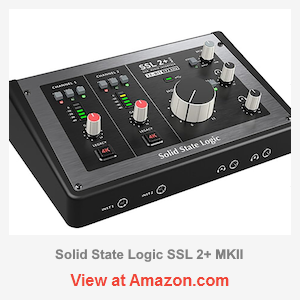 So, why spend the extra over the standard model?
So, why spend the extra over the standard model?
- Second headphone out — Not just convenient, essential for real collaboration
- MIDI I/O — Opens doors for hybrid workflows with hardware gear
- More outputs — Balanced monitor outs and unbalanced RCA outputs make it more versatile for connecting DJ setups, extra speakers, or external recorders
- More control — Ergonomically better layout with extra routing options built in
These aren’t just throwaway extras. They’re workflow unlocks—especially if you’re working with someone else, doing content creation with multiple outputs, or just want to route audio creatively. If you’re only ever plugging in one mic at a time and monitoring on headphones, sure, the standard model does the job. But if you’re even thinking about expanding, the 2+ gives you room to grow. And the best part? – It keeps the same compact footprint with no added bulk on your desktop.
Summary
The SSL 2 MKII and 2+ MKII deliver a miniature Solid State Logic console experience for desktop studios.
They offer pro-grade sound – transparent, low-noise preamps and high-res converters – in a simple, rugged package. Key features like dual headphone outputs, a mix knob, and the 4K switch make everyday tasks from tracking guitar to streaming interviews very convenient. The SSL2+ MKII’s extra outputs and MIDI I/O add flexibility for more complex setups, while the base SSL2 MKII covers essential needs. To sum it up, these interfaces just work and inspire confidence: monitor mixes are clear, recordings come out clean, and the overall workflow is smooth.
Pros: High-end SSL preamps (64 dB gain, –130 dBu EIN) and new 32-bit/192 kHz converters ensure top-notch sound. Robust build with Alps/Neutrik components. Two headphone outputs with strong amps. Handy features (HPF switches, Mix knob, stereo/mono). Lots of bundled plugins and DAW software. Finally aestetics and buld quality. It’s the kind of design that naturally puts you in a creative, working mindset.
Considerations: The unit is bus-powered only (no DC jack), so use on the go. Some may wish for a metal chassis (the plastic sides are very solid, though). The 4K mode is subtle and may or may not be needed. Overall, however, the SSL 2/2+ MKII cover all bases reliably and live up to their pro-audio heritage.
Bottom Line: SSL’s SSL 2 MKII and SSL 2+ MKII are well-built, all-SSL-sound audio interfaces that capture every detail and work as expected. They give home producers and content creators essentially the core of an SSL console – great pres, flexible routing, solid build – in a compact package. This makes them ideal for podcasting, music production or streaming where reliable, top-quality sound is needed with no fuss.


